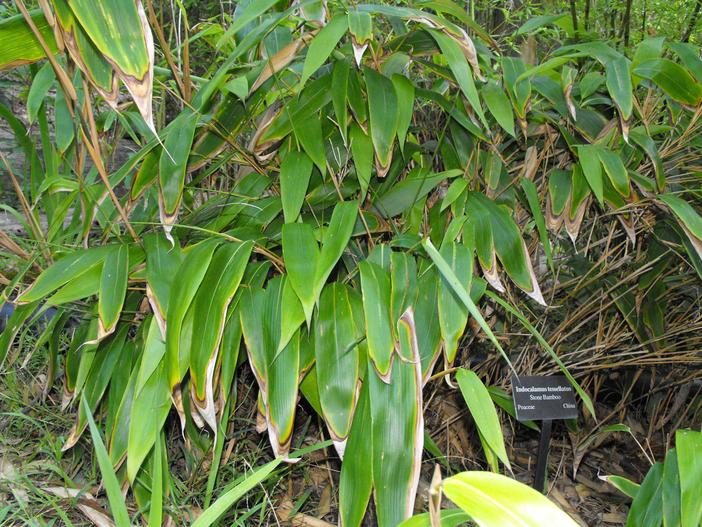Large-Leaved Bamboo
(Indocalamus tessellatus)
Large-Leaved Bamboo (Indocalamus tessellatus)
/
/

Stickpen
Public domain
Image By:
Stickpen
Recorded By:
Copyright:
Public domain
Copyright Notice:
Photo by: Stickpen | License Type: Public domain | License URL: https://creativecommons.org/public-domain/ | Uploader: Stickpen | Publisher: Wikipedia Commons











Estimated Native Range
Summary
Indocalamus tessellatus, commonly known as large-leaved bamboo, is an evergreen bamboo species native to the understory of broadleaf forests in China. It is particularly adapted to the shaded, moist, and well-drained soils found in these environments. This medium-sized bamboo can reach up to 7 feet in height and is notable for its exceptionally broad leaves, which can be up to 24 inches long and 4 inches wide. The weight of the leaves often causes the slender canes to arch gracefully.
Large-leaved bamboo is valued for its ornamental foliage and its ability to create dense thickets, providing a lush, tropical effect in gardens. It is hardy to -15°C and prefers semi-shade, thriving in moist, rich soil. While it can spread to form large groves in ideal conditions, it is also suitable for container cultivation, which can help control its spread. In the UK, it has been recognized with the Royal Horticultural Society’s Award of Garden Merit. Gardeners should be aware that, like many bamboos, it can become invasive if not managed properly, so measures such as root barriers may be necessary. It is often used in gardens for screening purposes, as a focal point, or as part of an Asian-themed garden design.CC BY-SA 4.0
Large-leaved bamboo is valued for its ornamental foliage and its ability to create dense thickets, providing a lush, tropical effect in gardens. It is hardy to -15°C and prefers semi-shade, thriving in moist, rich soil. While it can spread to form large groves in ideal conditions, it is also suitable for container cultivation, which can help control its spread. In the UK, it has been recognized with the Royal Horticultural Society’s Award of Garden Merit. Gardeners should be aware that, like many bamboos, it can become invasive if not managed properly, so measures such as root barriers may be necessary. It is often used in gardens for screening purposes, as a focal point, or as part of an Asian-themed garden design.CC BY-SA 4.0
Plant Description
- Plant Type: Grass
- Height: 3-9 feet
- Width: 3-15 feet
- Growth Rate: Moderate
- Flower Color: N/A
- Flowering Season: Non-Flowering
- Leaf Retention: Evergreen
Growth Requirements
- Sun: Full Sun, Part Shade
- Water: Medium
- Drainage: Medium
Common Uses
Groundcover, Low Maintenance
Natural Habitat
Understory of broadleaf forests in China
Other Names
Common Names: Tessellated Bamboo
Scientific Names: , Indocalamus tessellatus, Arundinaria hamadae, Arundinaria ragamowskii, Arundinaria tessellata, Arundo ragamowskii, Bambusa ragamowskii, Bambusa reticulata var. macrophylla, Bambusa reticulata var. macrophylla, Bambusa tessellata
GBIF Accepted Name: